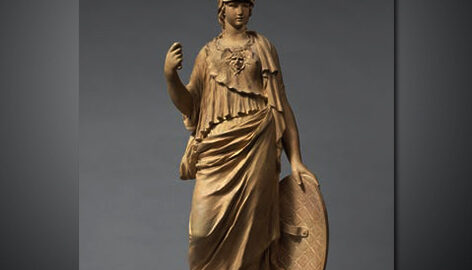

Deities were common deception on the reverse of the Roman coins. These were used if an emperor wished to be associated with attributes of the particular gods and goddess. More often gods were used rather than goddesses. For example, if the emperor wanted to appear peaceful he could depict ‘Minerva Pacifiera’ as the ‘Bringer of peace’. Furthermore, the deities were depicted by the Emperors so they can use the image to suggest the gods approved of and support their reign or associate themselves with the divine as Julius Caesar did with his depiction of Goddesses Venus
Goddess Venus
Venus was an integral part of the religious life of Rome, one of her major deities. In fact it is possible that she may have begun as an abstraction like Victory and Hope before becoming identified with the Greek Aphrodite. Her worship survived unofficially even into the Christian fourth century.
According to Roman mythology, Venus is the ancestor of the Roman people, as Romulus and Remus were the descendent of the Aeneas – the Trojan Hero and son of Venus.
The first coin is the above-given image was issued by moneyer L. Memmius Galerius known only from his coins and apparently from the less important branch of the Memmii. This denarius, from 106 BCE, shows Venus riding in a slow biga, with Cupid (her child) flying above carrying an open wreath. Venus is shown because she was the tutelary deity of the Memmii, who claimed descent from the Trojan Mnestheus, who accompanied Aeneas to Italy.
This coin is a serrate denarius, with a notched edge. Many Republican denarii were made like this. It might have been an attempt to discourage forgery, though there is no evidence that it actually did. This coin can be added to the collection of the series of goddesses on the Roman coins.
Goddess Vesta
Veta is the Roman equivalent of the Greek goddess Hestia. The goddess of family values and domestic life. Vesta was considered by the Roman to be the role model for women and as such, she appeared frequently on a coin of the Roman empress.
As a model for the Roman matron, Vesta is always depicted wearing the stola and palla and holding a combination of the patera, simpulum, sceptre, torch or palladium. It is believed that Palladium was a statue of Athena believed to have been brought by Aeneas from Troy.
The above silver denarius depicts Vesta in a standing form facing left with a patera in the left hand and transverse sceptre in right. This coin was issued in 222 to 235 AD by Julia Mamaea, empress of Rome during the Severan dynasty. This coin is the best example to connect to the goddess on the Roman coins.
Goddess Flora
According to Roman Folklore, Goddess Flora is associate with the season of spring. She is also connected season of rejuvenation bust also budding youth which makes her an important Roman goddess.
Flora festival is celebrated as the renewal of the circle of life, flower and drinking started in 240 BC. Rose festival is also celebrated in her name. Flora became more famous in the Renaissance humanists period.
During the Republic period, Flora started appearing on the coin in humanoid form. Mostly she represented in wreath form in the early period. Around 57 BC Flora appeared on the coin in her human personification. The above shown silver denarius depicted bust of Flora wearing a wreath facing right with lituus behind her and legend ‘FLORA PRIMUS’ on her right.
This coin was issued during the Roman Republic under the authority of moneyer C. Sevillius. He belongs to the Alban family who migrated to Rome after the destruction of Alba.
Goddess Fortuna
Fortuna was the Italian goddess of chance or luck in the sense of good fortune, bad fortune, and the future. She contributes to steering the course of events, hence the rudder. Good fortune brings abundance, hence the cornucopia. Our terms “fortunate” and “fortune teller” derive from Fortuna. One aspect pertained to fortune in battle. Fortuna REDVX is her aspect relating to a safe return from trips.
This silver Antoninianus during Gordian III reign depicts Fortuna in a seated position with a cornucopia in left-hand anchor in the right hand. It may be the sign of obtaining fortune through marine trade.
In the above commentary, the four most important roman goddess of roman Parthenon discusses. Each and every goddess have their own importance and significance. These goddesses are most featured divine females on the roman coins due to their significant job and position in the belief of the roman republic and imperial states.
The Mintage World Team comprises of experts, researchers and writers from the field of Philately, Notaphily and Numismatics who try to shed light on some of the most interesting aspects of coins, banknotes and stamps from not just India but across the globe as well.